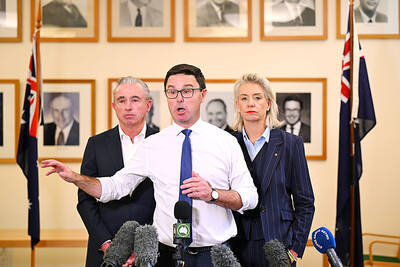The South Korean military yesterday said it had fired warning shots to repel a North Korean patrol vessel that temporarily crossed the countries’ disputed western sea boundary while chasing a Chinese fishing boat.
The North Korean patrol boat crossed the so-called Northern Limit Line at about 11am on Saturday while pursuing the Chinese boat in waters near South Korea’s Baekryeong Island, but immediately retreated after a South Korean naval vessel fired warning shots, the South Korean Joint Chiefs of Staff said.
While there were no exchanges of fire between the North and South Korean vessels, the South Korean high-speed vessel collided with the Chinese boat as it responded to the intrusion amid poor visibility, causing bruises and other minor injuries to some of the South Korean sailors.

Photo: EPA-EFE
The Joint Chiefs of Staff said that the South Korean military is closely monitoring North Korean military activities while preparing for various possibilities of provocation.
The South Korean navy has often fired warning shots to repel North Korean vessels crossing the countries’ poorly marked sea border, but there also have been some deadly clashes over the past decades. South Korea blamed North Korea for an attack on a South Korean warship that killed 46 sailors in 2010, but Pyongyang has denied responsibility.
Saturday’s intrusion came amid heightened tensions in the region as the pace of North Korea’s weapons demonstrations and the US-South Korean joint military exercises aimed at countering the North Korean threat have intensified in a cycle of tit-for-tat.
The South Korean and US militaries are conducting another large-scale joint exercise from next week, involving about 110 warplanes, including advanced F-35 fighter jets.
‘JOINT DEFENSE POSTURE’
The South Korean Ministry of National Defense said the aerial drills, which begin today and continue through Friday next week, are aimed at sharpening combined operational abilities and demonstrating the allies’ joint defense posture in the face of North Korean threats.
North Korea last week staged one of its most provocative military displays in the past few years by test firing what it described as a solid-fuel intercontinental ballistic missile, which, if perfected, could potentially give the North a more powerful and harder-to-detect weapon targeting the mainland US.
South Korean officials also say North Korea has not been responding to South Korean calls on a set of cross-border inter-Korean hotlines for more than a week, which raises concerns about potential kinetic provocations, as communications on those channels are meant to prevent accidental clashes along the sea border.

FRAUD ALLEGED: The leader of an opposition alliance made allegations of electoral irregularities and called for a protest in Tirana as European leaders are to meet Albanian Prime Minister Edi Rama’s Socialist Party scored a large victory in parliamentary elections, securing him his fourth term, official results showed late on Tuesday. The Socialist Party won 52.1 percent of the vote on Sunday compared with 34.2 percent for an alliance of opposition parties led by his main rival Sali Berisha, according to results released by the Albanian Central Election Commission. Diaspora votes have yet to be counted, but according to initial results, Rama was also leading there. According to projections, the Socialist Party could have more lawmakers than in 2021 elections. At the time, it won 74 seats in the

A Croatian town has come up with a novel solution to solve the issue of working parents when there are no public childcare spaces available: pay grandparents to do it. Samobor, near the capital, Zagreb, has become the first in the country to run a “Grandmother-Grandfather Service,” which pays 360 euros (US$400) a month per child. The scheme allows grandparents to top up their pension, but the authorities also hope it will boost family ties and tackle social isolation as the population ages. “The benefits are multiple,” Samobor Mayor Petra Skrobot told reporters. “Pensions are rather low and for parents it is sometimes

CONTROVERSY: During the performance of Israel’s entrant Yuval Raphael’s song ‘New Day Will Rise,’ loud whistles were heard and two people tried to get on stage Austria’s JJ yesterday won the Eurovision Song Contest, with his operatic song Wasted Love triumphing at the world’s biggest live music television event. After votes from national juries around Europe and viewers from across the continent and beyond, JJ gave Austria its first victory since bearded drag performer Conchita Wurst’s 2014 triumph. After the nail-biting drama as the votes were revealed running into yesterday morning, Austria finished with 436 points, ahead of Israel — whose participation drew protests — on 357 and Estonia on 356. “Thank you to you, Europe, for making my dreams come true,” 24-year-old countertenor JJ, whose

BACKLASH: The National Party quit its decades-long partnership with the Liberal Party after their election loss to center-left Labor, which won a historic third term Australia’s National Party has split from its conservative coalition partner of more than 60 years, the Liberal Party, citing policy differences over renewable energy and after a resounding loss at a national election this month. “Its time to have a break,” Nationals leader David Littleproud told reporters yesterday. The split shows the pressure on Australia’s conservative parties after Prime Minister Anthony Albanese’s center-left Labor party won a historic second term in the May 3 election, powered by a voter backlash against US President Donald Trump’s policies. Under the long-standing partnership in state and federal politics, the Liberal and National coalition had shared power